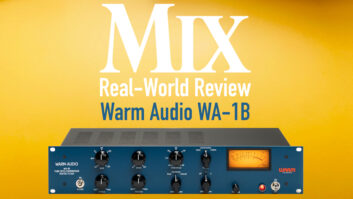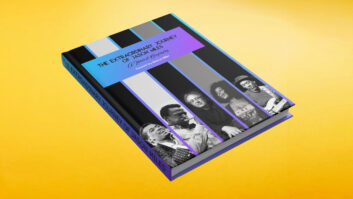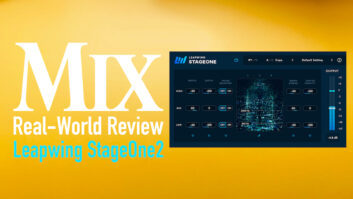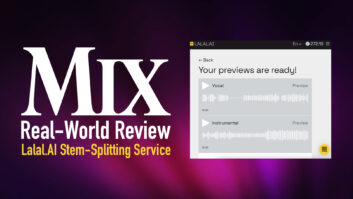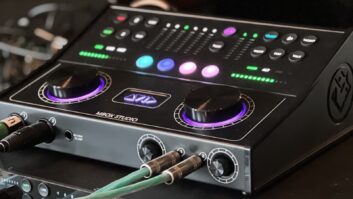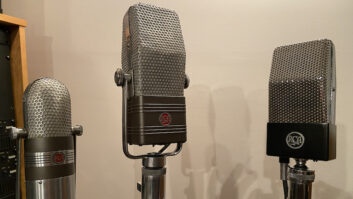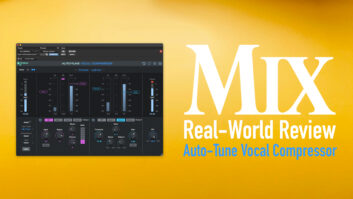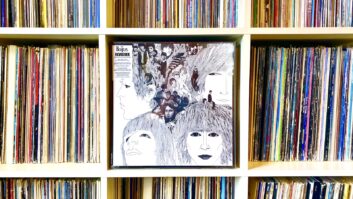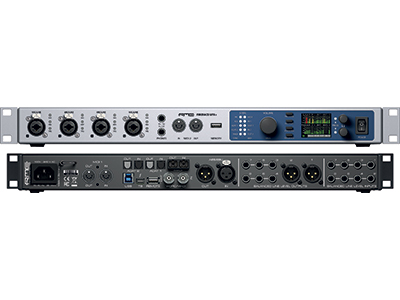
In 2004, when RME released the first product in its Fireface line, Firewire audio interfaces were still a relatively new concept. The Fireface 800 had a ridiculous I/O count for the time, taking advantage of ADAT, S/PDIF and AES/EBU, in addition to analog I/O. The latest in the family, the Fireface UFX+, is right in step with the expectations set forth by the its predecesssors. With the new model, the I/O count rises to 188 total channels by adding MADI connectivity, and Thunderbolt or USB 3.0 provides the necessary bandwidth for getting into your Mac or PC. This amount of power, paired with a newly designed software mixer, suggests that the Thunderbolt era is a perfect home for RME’s way of thinking.
THE BASICS
The Fireface UFX+ is a single-rackspace interface whose full potential depends on Thunderbolt or USB 3.0 connectivity; for the sake of compatibility, USB 2.0 is also supported at the expense of MADI I/O. The interface provides 12 AD converters. Eight balanced line-level signals can be accepted through the rear-panel TRS connections, while the other four channels of input are accessible through front-panel XLR/TS ¼-inch combo jacks. The four front-panel inputs are each equipped with high-quality mic preamps capable of providing up to 75 dB of gain. The ¼-inch component of the combo jack is designed to accept high-impedance instrument signals, as an alternative to the mic input.
There are also 12 included channels of DA conversion. Four are broken into a pair of high-gain, low-distortion headphone outputs found on the front panel. A pair of rotary encoders, which can be repurposed as input gain controls, adjust the output level of each of these jacks by default. While the control room level can be dimmed or muted using the included software, there are no physical controls for dim or mute functions. It would be nice if pressing the rotary encoder, for example, muted the output, but this is not the case. The remaining six channels of DA feed a set of ¼-inch TRS connectors on the rear panel.
Other I/O includes four Toslink connectors, a pair of XLR connections providing stereo AES/EBU I/O, and MADI I/O offering 64 input channels and 64 output channels using the SC optical connector type, with included dust caps. A pair of BNC word clock input and output connectors can be repurposed as MADI connectors, instead of using the optical MADI I/O.
The Fireface UFX+ is meticulous about proper clocking, providing some functions to verify and stabilize throughout the system. In addition to the dedicated BNC wordclock I/O, the unit can feed clocking pulses to any digital audio output or slave from any of the digital inputs. When slaving to incoming signals, RME’s Steady-Clock technology accounts for the fact that clocking signals, which are embedded into data streams containing digital audio packets, are inherently prone to jitter. SteadyLock takes these questionable clock sources, removes the jitter, and tightens them up so that the unit’s own AD/DA will be extremely accurate even when clocking externally. This repaired clocking signal is also passed through the unit’s wordclock and digital audio outputs so that other digital gear connected to the Fireface UFX+ will be clocked equally accurately.
TOTALMIX FX
The TotalMix FX software, which handles routing duties for the Fireface UFX+, was a little overwhelming at first glance. Other software mixers that I’ve encountered, like Apogee’s Maestro, for example, have been clean, simple and intuitive enough that I could easily build headphone mixes minutes after taking the hardware out of the box. The TotalMix FX software threw me for a loop. I tried clicking around, and after a while, I thought I had things figured out, but there were still a lot of functions that confused me. So I read the manual and realized that this software was extremely powerful and far more feature-packed than I imagined.
With TotalMix FX, any physical input or software return can be fed to any physical output. With 94 total input channels, 94 software returns, and 94 physical outputs to which any of those 188 sources could be routed, I suppose that simplicity is inherently out of the question. However, understanding the goals of the mixer, and how the software addresses these goals, I am extremely impressed with just how intuitive the mixer became. It is so well-designed, in fact, that the Fireface UFX+ could be considered for purchase not only as an audio interface but also merely as a MADI router, feeding MADI signals to and from different converters and destinations. To serve this purpose in the most basic way, a simple grid-style routing matrix, similar to the Pro Tools I/O settings window, is available.
For more advanced mixing, a full-on fader-based mixer takes on the task. Every single input and output has its three-band, fully parametric EQ, a highpass filter with adjustable slope and frequency, and dynamics processing, including an expander, compressor and customizable auto-leveler, which serves as a limiter. Every return has a send for Reverb/Delay.. On top of that, a pair of time-based processors providing reverb and delay can be fed by a single send from each source fader and returned at individualized levels on the fader feeding each output. Best of all, utilizing these effects has little impact on CPU performance, because the processors use the hardware’s DSP.
IN THE STUDIO
When I unboxed the Fireface UFX+, I was impressed right away by the build quality. The unit is housed in a sturdy steel chassis with a metal faceplate. A small, full-color display can show different functions like metering, input and output gain, different routing functions, as well as controls for the unit’s integrated USB recorder. Flipping through different menus using the onboard rotary encoders was a little clunky, as controls would address the functions of one menu but then revert to default functions in others. For many of the more complicated routing functions, using three knobs had a cumbersome, Etch-a-Sketch feel. In almost every case, aside from main output level, I avoided the onboard rotary encoders altogether and used the TotalMix FX software to control all functions.
I listened to the DA converters before I tracked anything with the unit. I shot the Fireface UFX+ out against my Dangerous Source, which I consider to have very clean, punchy and extremely transparent converters. The RME interface was sonically impressive, bringing a great amount of detail and a nice stereo image. I listened to many types of music, but across the board, the distinction between the two characters was very clear and consistent. Overall, the Fireface UFX+ had a slightly more aggressive lower midrange and low end, while the top end was a little smoother and less punchy.
Both showed a nice picture of the room in acoustic recordings and had a pleasantly balanced sound. I was satisfied enough with the Fireface’s converters that when doing remote tracking, rather than bringing my Dangerous Source along, I relied on the Fireface as a monitor controller. The unit performed admirably, though, again, I kept looking for a mute and dim control. I suppose that if I had had the optional ARC USB remote, its large rotary encoder and fully programmable buttons could have been made to perform these functions. Because the Fireface UFX+ only has four built-in mic preamps, I knew I was going to have to expand the I/O to record basic tracks for a full band. I chose an 8-channel preamp with ADAT output and word clock I/O and connected a Toslink cable to the first ADAT input of the Fireface. Immediately, the software control panel indicated that a connection was present, but lights started blinking on the interface as well as the mic preamp. The software control panel also blinked different sample rates in the ADAT 1 section.
I like how clear the Fireface’s software was about indicating a sample-rate mismatch and clocking problem. I connected a wordclock cable from the Fireface to the preamp, and double-checked the sample-rates and clocking settings on the devices and got solid lights on both. Some interfaces are much more ambiguous about differentiating between the signal present, sample-rate match and locked statuses. The Fireface helped me quickly diagnose the problem and confidently solve it.
Getting ready for a tracking session, I played with the software mixer and continually got overwhelmed by the amount of I/O presented. Conveniently, there were a variety of options to collapse different faders into a narrow meter-only view. On top of that, any channel of input, output or software return could be manually removed from the mixer if not being used. In my case, I never had the opportunity to use the MADI I/O, so I removed those 64 channels from the mixer and radically simplified the whole setup. Even after using it for a while, there were still moments when I would still get lost between the different mixer pages when building headphone mixes or got confused by the positioning of labels. I’m sure that day-to-day use would quickly bring proficiency.
I was very pleased with the sound of the built-in effects, particularly the reverb. It was not bright or cheesy in any of its modes. It was pleasant and usable and complemented drums and vocals nicely. It was great for giving a singer confidence during tracking. The dynamics processors were also handy, especially the auto-level on headphone master faders. As more and more layers of overdubbing built up, it did a nice job of preventing the overall level from overdriving the output.
When I got into tracking, I was impressed by the amount of headroom afforded by the built-in mic preamps. In one instance, I had kick and snare on the first two preamps and was never looking for a pad. The sound of each was full and had a great sense of realism—very punchy and clean with no hint of grit or distortion.
I liked the preamps on a miked a guitar amp. In one case, the guitarist was using a slightly dirty tone with some chorus, delay and spring reverb. I had a condenser backed off about a foot and a half aimed straight on axis with the amp’s speaker. The reverb, combined with the little bit of room that was being picked up, created this perfect image of the sound, just like we heard it in the room. Despite the fact that the amp was cranked to a pretty loud volume, the preamp captured the sound with great clarity and no additional distortion; it never sounded harsh.
Again, on vocals, the Fireface’s preamps captured all of the air and detail of the performance. My only complaint would be that there are only four preamps. I would have gladly used them on anything. I also wound up connecting the direct output of the bassist’s amp to one of the line-level inputs of the Fireface UFX+. In this case, the unit’s preamps weren’t involved, but the AD converter still played a role. We never connected the amp directly to a cabinet, so I only heard it through the converters, but the sound was phenomenal. The bass had a rich character with a gigantic bottom end, and a smooth, yet detailed string attack in the top end. Altogether, it cut well through the mix, though in sections where the bass was featured more, it never sounded brash or clicky.
Across the board, I liked the sound of the AD and DA converters. Listening back to a rough mix, where most of the tracks were cut with Fireface preamps and converters, there was this dark, warm Neve-like character to the track. The top end was wide, complicated and detailed; it would not be described as bright or brittle.
With more and more exposure, the mixer became easier to use, and the onboard effects were a nice touch. I wish it were easier to set levels, engage phantom power and deal with inputs using tactile controls rather than software. Despite that, I preferred the Fireface UFX+ over many other interfaces regarding ease of use, and it made a very short list regarding sound.
There are only a handful of high-I/O count, Thunderbolt interfaces at this price point right now, so the the Fireface UFX+ joins the Apogee Ensemble Thunderbolt, UAD Apollo 16, Focusrite Red 4Pre, Antelope Orion Studio, and Lynx Hilo regarding price and features. The MADI I/O and the general variety of input and output types would be one thing that sets this unit apart. On top of that, the software mixer is probably the most powerful in the class regarding routing.
The Fireface UFX+ comes up a little short regarding the number of builtin preamps, so that might lead some customers to look at the Apogee Ensemble or Antelope Orion. However, if you can get away with four great-sounding, built-in preamps, if you demand very flexible routing, and particularly if MADI I/O fits your needs, you can’t go wrong with this unit.
PRODUCTSUMMARY
COMPANY: RME
PRODUCT: Fireface UFX+
WEBSITE: www.rme-audio.de/en/
PRICE: $2,799 (Street)
PROS: Variety of I/O with extremely|flexible routing
CONS: Only four built-in mic preamps
Brandon T. Hickey is an audio engineer specializing in sound for post-production.
